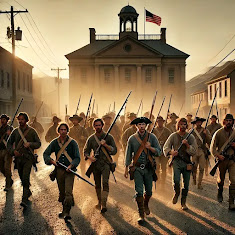A Crisis in Post-Revolutionary Pennsylvania
In September 1791, the quiet town of Lewistown, Pennsylvania, was thrown into turmoil when an armed mob stormed the courthouse, intent on forcibly removing Judge Samuel Bryson from the bench. The attack was fueled by resentment, personal ambition, and a dangerous disregard for the rule of law.
As the situation
spiraled out of control, the arrival of Colonel Daniel McFarland and his
militia turned the tide, restoring order and ensuring that justice prevailed.
The events of the Mifflin County Insurrection would become a significant
chapter in Pennsylvania’s early history, illustrating the challenges of
maintaining law and order in a rapidly changing nation.
A Conspiracy Against the Courts
The trouble began
when Samuel Bryson was appointed second associate judge of the Mifflin
County Court of Common Pleas. His previous role as Lieutenant Colonel of the
militia had placed him in a position to influence officer promotions, and
his opposition to commissioning William Wilson and David Walker
as militia colonels led to their deep resentment.
Determined to remove
Bryson by force, Wilson and Walker gathered a force of 40 armed men and
marched into Lewistown with a fife playing, their intentions clear:
seize the judge from the courthouse, force his resignation, and exile him to
the rugged terrain along the Juniata River.
The Riot Breaks Out
 As the mob arrived
at the courthouse, Judge Bryson quickly folded his robe and retreated to an
adjoining chamber, avoiding immediate capture. Meanwhile, Judge Story, another
magistrate who had learned of the planned attack, attempted to sound the alarm
but was intercepted and forcibly detained by the rioters.
As the mob arrived
at the courthouse, Judge Bryson quickly folded his robe and retreated to an
adjoining chamber, avoiding immediate capture. Meanwhile, Judge Story, another
magistrate who had learned of the planned attack, attempted to sound the alarm
but was intercepted and forcibly detained by the rioters.
The situation
escalated as Wilson and Walker’s men stormed the courthouse,
overpowering court officers and seizing Judge Bryson. It seemed as though the
mob’s plan would succeed—until the next day, when the tables turned.
Col. Daniel McFarland & The Militia Response
On the day following the riot, Colonel Daniel McFarland arrived in Lewistown with the local militia, prepared to confront the insurrectionists. He delivered a strong address condemning the riot and declared that his forces would defend the judiciary at any cost. His firm stance immediately changed the course of events.
The rioters, sensing
their impending defeat, began to waver. Their courage quickly faded in the face
of McFarland’s unwavering force. Wilson and Walker, once emboldened, now
found themselves isolated as their support crumbled. In a matter of hours,
the insurrection collapsed. The court reconvened, and the judges issued a
formal statement thanking McFarland and his militia for their swift action,
acknowledging their role in upholding the integrity of the judiciary.
But tensions in
Lewistown had not fully settled. That evening, another group of armed men
attempted to storm the local prison to free the sheriff, who had been
detained earlier in the day. Rumors spread that reinforcements from
Tuscarora Valley were on their way, threatening to escalate the violence.
Fortunately, before another confrontation could break out, news arrived that
the sheriff had already been released, preventing further bloodshed.
The Aftermath of the Riot
The Mifflin County
Insurrection was a stark warning about the dangers of lawlessness and unchecked
ambition. Had it not been for the decisive action of Colonel McFarland and his
forces, the attack on Judge Bryson could have set a dangerous precedent for Pennsylvania’s
courts.
McFarland’s swift
intervention ensured that justice remained intact and that those who sought
to overthrow the courts by force did not succeed. His efforts not only
ended the immediate crisis but also served as a reminder that the rule of law
must be protected, even in the face of violent opposition.
Postscript: Identifying Colonel McFarland
The Colonel
McFarland who played a key role in restoring order in Mifflin County was
most likely Colonel Daniel McFarland of Pennsylvania (1731–1817). A
seasoned military officer, he had previously served as a Commander of
Rangers in Monongalia and Ohio Counties in 1778 and was involved in militia
efforts during the Revolutionary War. He also had ties to Washington County,
PA, where he helped establish Fort McFarland around 1772.
While there was
another Col. Daniel McFarland from Massachusetts, his known activities
were centered in New England, making it unlikely that he played a role in the
events of Mifflin County. Given the location and military background of the
Pennsylvania-based McFarland, it is almost certain that he was the leader
who quelled the 1791 riot.
Sources Cited
- The Mifflin County Insurrection, Primary
Source Transcription, Freeman’s Journal/North-American Intelligencer,
September 28, 1791.
- Col. McFarland’s Role in the Riot, Philadelphia
Gazette of the United States, September 28, 1791.
- DAR Application Summary on Daniel
McFarland, Nellie Elizabeth Phillips Trotter, Daughters of the American
Revolution Archives.
- McFarland’s Military Service
& Land Ownership, Daniel McFarland Facts
Document.
- Biographical Records of the
McFarland Family, Descendants of Daniel McFarland.




















%20during%20the%201860s.%20The%20design%20features%20a%20Missouri%20Confeder.webp)